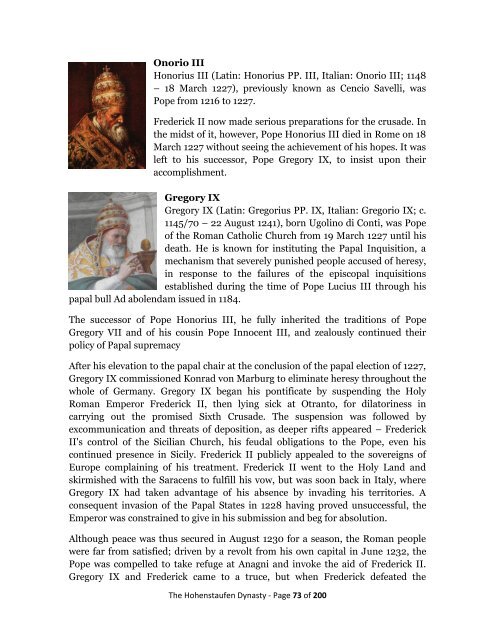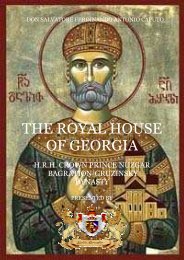here - Nobility Associations
here - Nobility Associations
here - Nobility Associations
Create successful ePaper yourself
Turn your PDF publications into a flip-book with our unique Google optimized e-Paper software.
Onorio III<br />
Honorius III (Latin: Honorius PP. III, Italian: Onorio III; 1148<br />
– 18 March 1227), previously known as Cencio Savelli, was<br />
Pope from 1216 to 1227.<br />
Frederick II now made serious preparations for the crusade. In<br />
the midst of it, however, Pope Honorius III died in Rome on 18<br />
March 1227 without seeing the achievement of his hopes. It was<br />
left to his successor, Pope Gregory IX, to insist upon their<br />
accomplishment.<br />
Gregory IX<br />
Gregory IX (Latin: Gregorius PP. IX, Italian: Gregorio IX; c.<br />
1145/70 – 22 August 1241), born Ugolino di Conti, was Pope<br />
of the Roman Catholic Church from 19 March 1227 until his<br />
death. He is known for instituting the Papal Inquisition, a<br />
mechanism that severely punished people accused of <strong>here</strong>sy,<br />
in response to the failures of the episcopal inquisitions<br />
established during the time of Pope Lucius III through his<br />
papal bull Ad abolendam issued in 1184.<br />
The successor of Pope Honorius III, he fully inherited the traditions of Pope<br />
Gregory VII and of his cousin Pope Innocent III, and zealously continued their<br />
policy of Papal supremacy<br />
After his elevation to the papal chair at the conclusion of the papal election of 1227,<br />
Gregory IX commissioned Konrad von Marburg to eliminate <strong>here</strong>sy throughout the<br />
whole of Germany. Gregory IX began his pontificate by suspending the Holy<br />
Roman Emperor Frederick II, then lying sick at Otranto, for dilatoriness in<br />
carrying out the promised Sixth Crusade. The suspension was followed by<br />
excommunication and threats of deposition, as deeper rifts appeared – Frederick<br />
II's control of the Sicilian Church, his feudal obligations to the Pope, even his<br />
continued presence in Sicily. Frederick II publicly appealed to the sovereigns of<br />
Europe complaining of his treatment. Frederick II went to the Holy Land and<br />
skirmished with the Saracens to fulfill his vow, but was soon back in Italy, w<strong>here</strong><br />
Gregory IX had taken advantage of his absence by invading his territories. A<br />
consequent invasion of the Papal States in 1228 having proved unsuccessful, the<br />
Emperor was constrained to give in his submission and beg for absolution.<br />
Although peace was thus secured in August 1230 for a season, the Roman people<br />
were far from satisfied; driven by a revolt from his own capital in June 1232, the<br />
Pope was compelled to take refuge at Anagni and invoke the aid of Frederick II.<br />
Gregory IX and Frederick came to a truce, but when Frederick defeated the<br />
The Hohenstaufen Dynasty - Page 73 of 200



